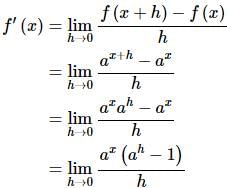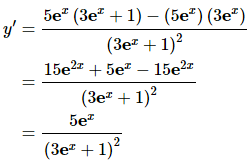Derivatives of Exponential and Logarithm Functions | Calculus - Mathematics PDF Download
The next set of functions that we want to take a look at are exponential and logarithm functions. The most common exponential and logarithm functions in a calculus course are the natural exponential function, ex, and the natural logarithm function, ln(x). We will take a more general approach however and look at the general exponential and logarithm function.
Exponential Functions
We’ll start off by looking at the exponential function,
f(x) = ax
We want to differentiate this. The power rule that we looked at a couple of sections ago won’t work as that required the exponent to be a fixed number and the base to be a variable. That is exactly the opposite from what we’ve got with this function. So, we’re going to have to start with the definition of the derivative.
Now, the ax is not affected by the limit since it doesn’t have any h’s in it and so is a constant as far as the limit is concerned. We can therefore factor this out of the limit. This gives,
Now let’s notice that the limit we’ve got above is exactly the definition of the derivative of f(x) = axatx = 0, i.e. f′(0). Therefore, the derivative becomes,
f′(x)=f′(0)ax
So, we are kind of stuck. We need to know the derivative in order to get the derivative!
There is one value of a that we can deal with at this point. Back in the Exponential Functions section of the Review chapter we stated that e = 2.71828182845905 … What we didn’t do however is actually define where e comes from. There are in fact a variety of ways to define e . Here are three of them.
Some Definitions of e
2. e is the unique positive number for which
The second one is the important one for us because that limit is exactly the limit that we’re working with above. So, this definition leads to the following fact,
Fact 1
For the natural exponential function, f(x)=ex we have
So, provided we are using the natural exponential function we get the following.
At this point we’re missing some knowledge that will allow us to easily get the derivative for a general function. Eventually we will be able to show that for a general exponential function we have,
Logarithm Functions
Let’s now briefly get the derivatives for logarithms. In this case we will need to start with the following fact about functions that are inverses of each other.
Fact 2
If f(x) and g(x) are inverses of each other then,
So, how is this fact useful to us? Well recall that the natural exponential function and the natural logarithm function are inverses of each other and we know what the derivative of the natural exponential function is!
So, if we have f(x) = ex and g(x) = ln x then,
The last step just uses the fact that the two functions are inverses of each other.
Putting this all together gives,
Note that we need to require that x>0 since this is required for the logarithm and so must also be required for its derivative. It can also be shown that,
Using this all we need to avoid is x=0.
In this case, unlike the exponential function case, we can actually find the derivative of the general logarithm function. All that we need is the derivative of the natural logarithm, which we just found, and the change of base formula. Using the change of base formula we can write a general logarithm as,
Differentiation is then fairly simple.
We took advantage of the fact that a was a constant and so lna is also a constant and can be factored out of the derivative. Putting all this together gives,
Here is a summary of the derivatives in this section.
Okay, now that we have the derivations of the formulas out of the way let’s compute a couple of derivatives.
Example 1 Problem Statement.
Solution:
(a) R(w) = 4w − 5log9w
This will be the only example that doesn’t involve the natural exponential and natural logarithm functions.
(b) f(x) = 3ex + 10x3 lnx
Not much to this one. Just remember to use the product rule on the second term.

We’ll need to use the quotient rule on this one.
There’s really not a lot to differentiating natural logarithms and natural exponential functions at this point as long as you remember the formulas. In later sections as we get more formulas under our belt they will become more complicated.
Next, we need to do our obligatory application/interpretation problem so we don’t forget about them.
Example 2 Suppose that the position of an object is given by
s(t)=tet
Does the object ever stop moving?
Solution:
First, we will need the derivative. We need this to determine if the object ever stops moving since at that point (provided there is one) the velocity will be zero and recall that the derivative of the position function is the velocity of the object.
The derivative is,
s′(t)=et+tet=(1+t)et
So, we need to determine if the derivative is ever zero. To do this we will need to solve,
(1+t)et=0
Now, we know that exponential functions are never zero and so this will only be zero at t = −1. So, if we are going to allow negative values of t then the object will stop moving once at t = −1. If we aren’t going to allow negative values of t then the object will never stop moving.
Before moving on to the next section we need to go back over a couple of derivatives to make sure that we don’t confuse the two. The two derivatives are,
It is important to note that with the Power rule the exponent MUST be a constant and the base MUST be a variable while we need exactly the opposite for the derivative of an exponential function. For an exponential function the exponent MUST be a variable and the base MUST be a constant.
It is easy to get locked into one of these formulas and just use it for both of these. We also haven’t even talked about what to do if both the exponent and the base involve variables. We’ll see this situation in a later section.
Practice problems: Derivatives Of Exponential And Logarithm Functions
For problems 1 – 6 differentiate the given function.
1. Differentiate f(x) = 2ex − 8x.
Solution:
Not much to do here other than take the derivative using the formulas from class.
2. Differentiate g(t) = 4log3(t) − ln(t).
Solution:
Not much to do here other than take the derivative using the formulas from class.
3. Differentiate R(w) = 3wlog(w).
Solution:
Not much to do here other than take the derivative using the formulas from class.
Recall that log(x) is the common logarithm and so is really log10(x).
4. Differentiate y = z5 − ezln(z).
Solution:
Not much to do here other than take the derivative using the formulas from class.
5. Differentiate 
Solution:
Not much to do here other than take the derivative using the formulas from class.
6. Differentiate 
Solution:
Not much to do here other than take the derivative using the formulas from class.
7. Find the tangent line to f(x) = 7x + 4ex at x = 0.
Solution:
Step 1
We know that the derivative of the function will give us the slope of the tangent line so we’ll need the derivative of the function.
f′(x)=7xln(7)+4ex
Step 2
Now all we need to do is evaluate the function and the derivative at the point in question.
Step 3
Now all that we need to do is write down the equation of the tangent line.
8. Find the tangent line to f(x) = ln(x)log2(x) at x = 2.
Solution:
step 1
We know that the derivative of the function will give us the slope of the tangent line so we’ll need the derivative of the function.
Step 2
Now all we need to do is evaluate the function and the derivative at the point in question.
Step 3
Now all that we need to do is write down the equation of the tangent line.
9. Determine if is increasing or decreasing at the following points. 
(a) t = −4
(b) t = 0
(c) t = 10
Solution:
(a) t = −4
We know that the derivative of the function will give us the rate of change for the function and so we’ll need that.
Now, all we need to do is evaluate the derivative at the point in question. So,
V′(− 4) > 0 and so the function must be increasing at t = −4.
(b) t = 0
We found the derivative of the function in the first part so here all we need to do is the evaluation.
V′(0) > 0 and so the function must be increasing at t=0.
(c) t = 10
We found the derivative of the function in the first part so here all we need to do is the evaluation.
V′(10)<0 and so the function must be decreasing at t=10.
10. Determine if G(z) = (z − 6) ln (z) is increasing or decreasing at the following points.
(a) z = 1
(b) z = 5
(c) z = 20
Solution:
(a) z = 1
We know that the derivative of the function will give us the rate of change for the function and so we’ll need that.
Now, all we need to do is evaluate the derivative at the point in question. So,
G′(1) = ln(1) − 5 = −5 < 0
G′(1) < 0 and so the function must be decreasing at z = 1.
(b) z = 5
We found the derivative of the function in the first part so here all we need to do is the evaluation.
G′(5) > 0 and so the function must be increasing at z = 5.
(c) z = 20
We found the derivative of the function in the first part so here all we need to do is the evaluation.
G′(20) > 0 and so the function must be increasing at z = 20.
|
112 videos|65 docs|3 tests
|
FAQs on Derivatives of Exponential and Logarithm Functions - Calculus - Mathematics
| 1. What is the derivative of the exponential function e^x? |  |
| 2. How do you differentiate a logarithmic function? |  |
| 3. Can you find the derivative of a function that contains both exponential and logarithmic terms? |  |
| 4. How do you find the derivative of the natural logarithm function ln(x)? |  |
| 5. What is the derivative of a constant raised to the power of x, such as a^x? |  |
















